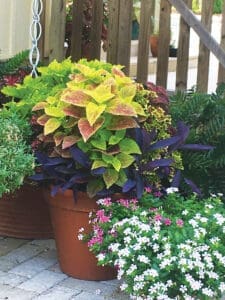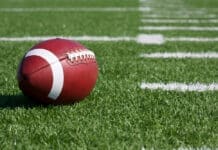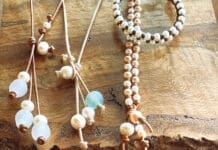By Alene Ogle, Okaloosa County Master Gardener Volunteer
 Below is a list of a few hardy and heat-tolerant Annuals and Perennials Master Gardeners have found successful. They will all make a colorful fall garden as well:
Below is a list of a few hardy and heat-tolerant Annuals and Perennials Master Gardeners have found successful. They will all make a colorful fall garden as well:
Gaillardia — Florida native, drought-tolerant, re-seeding, beautiful yellow, red and orange flowers, easy carefree, blooms spring to winter, pollinator attractor, full sun
Bulbine Frutescens — Drought-tolerant, grass-like foliage forms a clump reseeding, willowy flower stalks yellow and orange flowers, easy, carefree, blooms spring to winter, pollinator attractor, full sun to part shade, great container plant, easy to divide for propagation.
Blue Porterweed/Stachytarpheta Jamaicensis — Florida native, drought-tolerant, reseeding, blue or pink flowers are borne terminally on long stringy spikes at the end of the stems, easy, carefree, blooms spring to winter, pollinator attractor, full sun.
Pentas Lanceolate — Blooms spring to winter, pollinator attractor, flowers come in red, pink or white, easy, carefree, blooms spring to winter, pollinator attractor, full sun, annual
Cuban Buttercup/Turnera ulmifolia — Re-seeding, flowers are bright yellow, easy, carefree, blooms spring to winter, pollinator attractor, full sun, great container plant.
Vegetables:
See edis.ifas.ufl.edu Florida Vegetable Gardening Guide. This publication will provide you with site preparation, crops suited to our zone, when to plant, harvest time, fertilizing and pest management and is a very user-friendly site whether you are a pro or beginner.
What To Do In Your Landscape:
Lawns — Monitor your grass daily to be proactive for insect damage, disease, or irrigation failure. Most diseases and insects are seasonal. University of Florida websites can provide you with information by months so that you are identifying and treating your issues properly. The Florida friendly site can provide you with proper irrigation schedules which is vital in our hot and humid climate. Too much water from irrigation and rain can perpetuate diseases and make your lawn a desirable habitat for damaging pests.
Palms — Older palm fronds with yellowing may indicate a magnesium or potassium deficiency. Apply an appropriate palm fertilizer. http://edis.ifas.ufl.edu/topic_palm_nutrition
Ornamental plants — Rapid growth and leaching from rain and irrigation may result in nutrient deficiencies. Although about 16 elements are required for normal plant growth, only a few of these are commonly deficient in Florida landscape plants. See http://edis.ifas.ufl.edu/topic_nutrient_deficiencies_landscape_plants.
Annuals and Perennials — Remove spent blooms, cut back and fertilize flowering annuals and perennials to extend the season into the fall months. Check your containers to be sure they are not root bound; this will limit their water and nutrient intake. Don’t forget airflow; if your plants or shrubs are too thick you might need to prune or thin.
This link from the University of Florida Institute of Food and Agricultural Sciences lists plants that are suited to our North Florida climate: https://edis.ifas.ufl.edu/ep451#SECTION_8.






























































